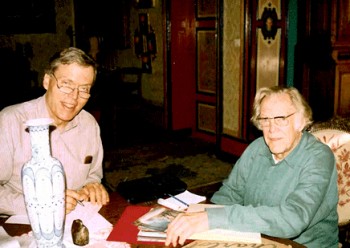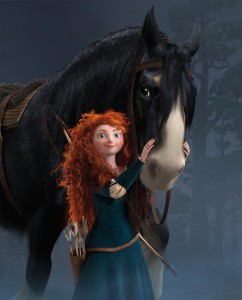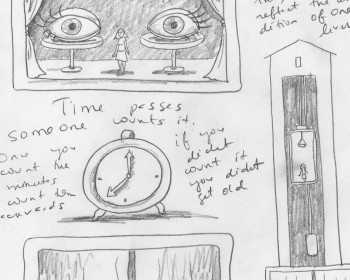Art Art &Commentary 16 Jun 2012 06:06 am
Promises
 - I don’t know about you, but I love to read interviews. The longer the better. When things go a while and there’s been nothing available, I’ll turn to Mike Barrier‘s site and find something in the archive to reread. For my money, the animation interviews he posts are by far the best available to me. There’s so much in his interview scripts that even rereading for the fifth or sixth time, there’s still plenty to be gleaned in them. I’ve certainly read the _________________Barrier & John McGrew
- I don’t know about you, but I love to read interviews. The longer the better. When things go a while and there’s been nothing available, I’ll turn to Mike Barrier‘s site and find something in the archive to reread. For my money, the animation interviews he posts are by far the best available to me. There’s so much in his interview scripts that even rereading for the fifth or sixth time, there’s still plenty to be gleaned in them. I’ve certainly read the _________________Barrier & John McGrew
John Hubley, John McGrew and
David Hand interviews more than six times. You’d think I’d be taking notes, by now. No, I just enjoy them as reading material. It’s almost like rereading a Barbara Pym novel, I gobble them up and absorb the characters at play; I enjoy the thrust of the lives in discussion and it doesn’t matter that I know where the story is going. Of course, it helps a lot that I have a real interest in the players and what they’ve gone through, and, in fact, I’ve known a few of them. Many of the others, i feel as though I’ve known them from reading about them and/or studying their work.
Somehow it’s more fun to me to read them rather than listen to audio recordings of them. Especially if the interviewers are good. Michael Barrier and his coauthor, Milt Gray, are formidable at the job, and they seem to get so much out of even the quietest apple. The interview with Fred Kopietz is a fine example. He’s someone who didn’t dominate animation history, but the story he tells is enormous. We get such a good view and an understanding of some of the studios he attended. An interview like his doesn’t always happen; there are some who leave too many questions about what they’re remembering. Of course, the guide makes all the difference. Barrier so often gently coaxes the interviews onto a straight and arrow path. His mechanics in interviewing aren’t always evident, but one feels safe in his hands.
And then when a new interview is posited in the archive, it’s pure delight. This past week saw a very complex interview with Phil Monroe join the roster, and I’ve already read it three times. They’re too hard to read on line, so I usually print them out and have them in hand to read; That’s what I did with the Monroe interview. He had a lot to say about the organization of the Warner cartoon setup, and the material seemed relatively new for me. He had a lot to say about some curious characters – those directors, Jones, Clampett, Freleng and McKimson.
 The audio interviews at the Animation Guild Blog are good examples of the usual audio interviews. Steve Hulett does the interviewing and posts the pieces on the site. For the most part, they’re the voices of the living artist who has had a major career behind them. They have full histories that is usually trippingly told. It’s nice to hear the characters’ voices and the sound of their speech, but often the interviews are halting or repetitious and cumbersome. Sometimes, the interviews feel as though they’re forced in the approach and the stories don’t unfold simply. The interviewer becomes a character in his own right, and you almost feel as though you’re listening to two people being interviewed at the same time. You can tell when Mr. Hulett is excited by the material, and you can also hear when he’s not so involved in his part of the interview. __ Steve Hulett
The audio interviews at the Animation Guild Blog are good examples of the usual audio interviews. Steve Hulett does the interviewing and posts the pieces on the site. For the most part, they’re the voices of the living artist who has had a major career behind them. They have full histories that is usually trippingly told. It’s nice to hear the characters’ voices and the sound of their speech, but often the interviews are halting or repetitious and cumbersome. Sometimes, the interviews feel as though they’re forced in the approach and the stories don’t unfold simply. The interviewer becomes a character in his own right, and you almost feel as though you’re listening to two people being interviewed at the same time. You can tell when Mr. Hulett is excited by the material, and you can also hear when he’s not so involved in his part of the interview. __ Steve Hulett
There are always two personalities to follow in every one
of the interviews. I always listen to those Mr. Hulett posts, but I usually approach it more as a chore than as a pleasure. There’s something more enjoyable about the written word, and I sure prefer those. But I still don’t miss Mr. Hulett’s audio posts; I just haven’t been inspired to go back to listen to any of them a second time.
For the record, I have read Didier Ghez‘s collection of animation interviews, Walt’s People, and have gone through most of his books at least twice.
I’ve alslo enjoyed Don Peri‘s two books: Working with Walt and Workng with Disney. They’re both excellent books.
Animated Features
 - This coming Tuesday, the Academy is screening Pixar’s Brave. I’ll certainly see it, and I’ve invited a number of people to the screening. I want to make sure it has a good audience for that first screening. I wish I were a bit more excited about it, but I’m not and I don’t know why. I hope to enjoy it and will report on my thoughts next week.
- This coming Tuesday, the Academy is screening Pixar’s Brave. I’ll certainly see it, and I’ve invited a number of people to the screening. I want to make sure it has a good audience for that first screening. I wish I were a bit more excited about it, but I’m not and I don’t know why. I hope to enjoy it and will report on my thoughts next week.
Up to now, I’ve pushed to see any animated feature the Academy screens. Last year I had to sit through two full weeks of animated features to be able to vote for the Oscar nominees. It was a lot to take in, especially since most of the films aren’t great. So it’s better to take them on one-at-a-time during the actual year in order to assure I won’t have to cram them all in. I wish the Academy had screened Madagascar 3 for us, so that won’t be one of those many features I’ll be forced to absorb at the last minute.
Oh wait. I just remembered that the Academy isn’t going to let the NY contingent vote to select the animated feature nominees. Too few people showed up at last year’s event and the cost of shipping the films and screening them was prohibitive – given those who’d shown up. I have to admit I was disappointed that too few took part, but that’s the game.
Consequently, that means I’ll probably only see Madagascar 3 on DVD. And I guess I won’t get to see this year’s Whiskers or Chico & Rita unless I actually go to a theater to see them – if they become available. Whiskers still hasn’t played in NY. I could have seen it if I went, this year, to Annecy, but I didn’t.
Let’s face it, the animation members don’t all have the opportunity of voting on their category. This means that a few people in LA will control who gets nominated next year. The unfortunate thing is that it doesn’t make for the best for the category. The larger the vote, the better would be the outcome. The members, themselves, in NY are the problem, but what can be done. Personally, I think they should probably get rid of the category. Pixar will put a billion dollars into publicity to make sure the few in LA pick their movie, and it’ll probably win. It may even deserve it. But, to me, too few are selecting the sample, and the politics aren’t easy to overcome.
Harvestworks
 Harvestsworks is hosting an animation art program by artists, Gregory Barsamian, Emily Hubley, George Griffin, Holly Daggers and Jeff Scher. This art show and screening at Harvestworks is curated by Phyllis Bulkin-Lehrer. The works all explore the use of digital production in creating traditional projection methods. Whether using New Media or keeping it at arms length.
Harvestsworks is hosting an animation art program by artists, Gregory Barsamian, Emily Hubley, George Griffin, Holly Daggers and Jeff Scher. This art show and screening at Harvestworks is curated by Phyllis Bulkin-Lehrer. The works all explore the use of digital production in creating traditional projection methods. Whether using New Media or keeping it at arms length.
The show opened in New York this past Thursday and will continue thru until June 28th.
Location:
Harvestworks – www.harvestworks.org
596 Broadway, #602 | New York, NY 10012 | Phone: 212-431-1130
Subway: F/M/D/B to Broadway/Lafayette, R to Prince, 6 to Bleecker Street
The installation is open 1 – 6 pm Tuesdays – Saturdays and is FREE
Storyboard Approach
 - There’s an interesting post up at Signe Baumane‘s site. She does a video post of how she does storyboards for her in-progress feature, Rocks In My Pockets. She also posts a short video by Bill Plympton which explains how he does storyboards and how he uses them. The two have very contrasting methods.
- There’s an interesting post up at Signe Baumane‘s site. She does a video post of how she does storyboards for her in-progress feature, Rocks In My Pockets. She also posts a short video by Bill Plympton which explains how he does storyboards and how he uses them. The two have very contrasting methods.
Bill is an ex comic strip artist. To me, his storyboards are more comic strip than storyboard. They move from dynamic pose to dynamic pose without logically following the language of film. It tends to make for some uncomfortable cuts within his films but helps them appeal to the cartoonists out there. (I don’t think there’s a Plympton film that doesn’t have a cut where he crosses the 180, making it very frustrating to watch for people like me.)
Signe is a writer, so she doesn’t do storyboards. Or so she says. She starts each scene by going to the script and selecting text to illustrate/animate. Though she doesn’t properly board these scenes, she does a bevy of thumbnails for them. Then she plows into the animation and does the work. The interesting thing, to me, is that Signe DOES follow all the rules of filmmaking. My guess is that she does this instinctively from a long history of watching and absorbing film.
Two different approaches and unexpected results.
Take a look at the videos; they’re short.

on 16 Jun 2012 at 10:44 am 1.anik said …
I’m with Signe, storyboarding is like planning every step before a vacation – then what’s the fun in actually going if there is no more space for adventure? But, of course, this is only true for personal trips, if it’s a “business” trip with other people involved, then too many surprises along the way may not be as welcome.
on 16 Jun 2012 at 11:29 am 2.Yowp said …
I would be willing to plunk down good money right now if Mike Barrier were able get a publisher who would print all his old interviews just waiting to be read.
No one else seems to have bothered talking to some of his subjects and I’d love to read more than just the occasional quote in his book “Hollywood Cartoons.”
on 16 Jun 2012 at 12:14 pm 3.sandro Cleuzo said …
Hey Michael,
Just want to point out that the picture you have saying it’s Steve Hulett is in fact a picture of animator Frans Fischer who works at Disney.
Just you know.
Great to read your post.
on 16 Jun 2012 at 12:17 pm 4.Michael said …
Anik, Alfred Hitchcock once said that once he’d written the script, he felt he’d finished the film. The rest, to him, was boring. It was merely going through the motions to get what he’d already seen in his head on the screen.
Thanks, Sandro. I changed the picture. Since I’ve never met Steve, I have to trust the Google search, which isn’t very trustworthy.